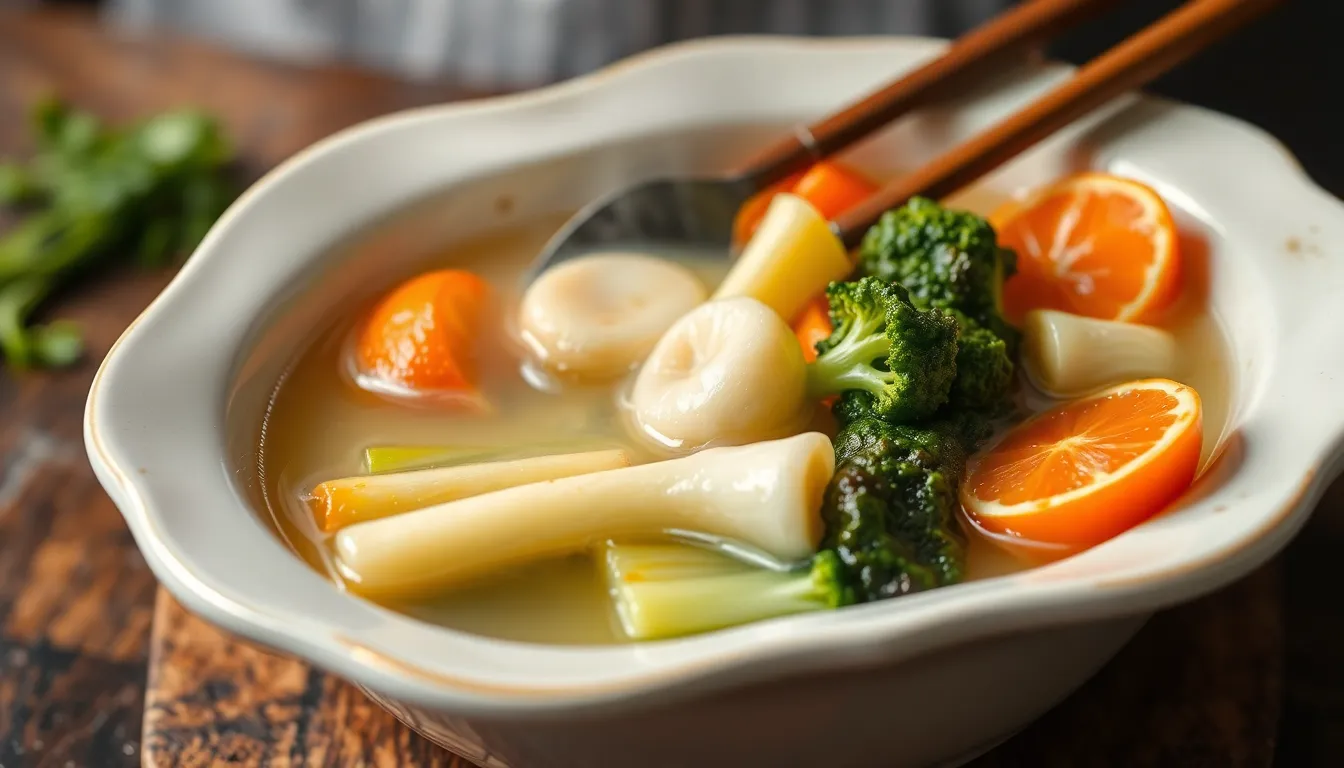table {
width: 100%;
border-collapse: collapse;
margin: 20px 0;
}
th, td {
border: 1px solid #ddd;
padding: 8px;
text-align: left;
}
th {
background-color: #f2f2f2;
}
ul {
margin: 10px 0;
padding-left: 20px;
}
Poaching Techniques for Perfectly Cooked Vegetables
Introduction
Poaching is a gentle cooking technique that allows you to cook vegetables in a flavorful liquid without losing their nutrients, color, or flavor. This method is not only healthy but also enhances the natural taste of your produce, making it an excellent choice for anyone looking to incorporate more vegetables into their diet. In this article, we will explore the intricacies of poaching, from understanding the technique to choosing the right vegetables and enhancing their flavor.
Section 1: Understanding Poaching
Poaching is defined as cooking food gently in liquid at a low temperature, typically between 160°F to 180°F (71°C to 82°C). This method differs from boiling, where food is submerged in bubbling water at higher temperatures, often resulting in a loss of nutrients and flavor.
The science behind poaching vegetables lies in the control of temperature and time. By maintaining a low and steady heat, the vegetables become tender without disintegrating. This technique is particularly effective for delicate vegetables that can easily overcook.
Section 2: Essential Equipment for Poaching
To poach vegetables successfully, you need a few key tools:
- Large saucepan or pot
- Slotted spoon
- Cooking thermometer
- Cutting board and knife
- Measuring cups and spoons
When selecting a pot for poaching, choose one that is wide and deep enough to hold plenty of water, allowing for even cooking. A heavy-bottomed pot is ideal, as it distributes heat evenly.
Comparison of Different Poaching Tools
| Tool | Description | Price Range | Best For |
|---|---|---|---|
| Slotted Spoon | A spoon with holes to easily lift poached vegetables | $5 – $20 | Removing vegetables from liquid |
| Saucepan | A deep pot for boiling or poaching | $15 – $100 | Cooking various vegetables |
| Thermometer | A tool to measure water temperature | $10 – $50 | Ensuring proper poaching temperature |
Section 3: Choosing the Right Vegetables to Poach
Not all vegetables are suitable for poaching. Here are some that excel with this technique:
- Carrots
- Asparagus
- Zucchini
- Green beans
- Cauliflower
- Broccoli
For the freshest produce, consider the seasons:
- Spring: Asparagus, peas
- Summer: Zucchini, green beans
- Fall: Carrots, cauliflower
- Winter: Broccoli, Brussels sprouts
Before poaching, prepare your vegetables by washing, peeling (if necessary), and cutting them into uniform sizes to ensure even cooking.
Section 4: Poaching Liquids
The choice of poaching liquid can significantly impact the flavor of your vegetables. Common options include:
- Water
- Vegetable broth
- White wine
- Herb-infused water
Infusing flavors into your poaching liquid with herbs, spices, and aromatics can elevate your dish. Some popular additions are:
- Garlic
- Thyme
- Bay leaves
- Lemon slices
Poaching Liquid Flavor Profiles
| Liquid Type | Flavor Notes | Best Vegetables |
|---|---|---|
| Vegetable Broth | Rich, savory | Carrots, broccoli |
| White Wine | Fruity, acidic | Asparagus, zucchini |
| Herb-Infused Water | Fresh, aromatic | Green beans, cauliflower |
Section 5: Step-by-Step Poaching Method
To poach vegetables, follow these detailed instructions:
- Preparation: Prepare your poaching liquid in a large saucepan. Bring it to a gentle simmer over medium heat.
- Temperature Control: Aim for a temperature range of 160°F to 180°F (71°C to 82°C). Always use a thermometer to monitor the heat.
- Cooking Times: Here are some general cooking times for various vegetables:
- Asparagus: 3-5 minutes
- Carrots (sliced): 5-7 minutes
- Green Beans: 4-6 minutes
- Zucchini (sliced): 2-4 minutes
- Cauliflower florets: 5-7 minutes
- Check for Texture: Use a slotted spoon to test the vegetables for doneness. They should be tender yet firm.
Section 6: Enhancing Flavor After Poaching
After poaching, enhance the flavor of your vegetables with simple seasonings. Here are some ideas:
- Drizzle with melted butter or olive oil
- Sprinkle with salt and pepper
- Add a splash of lemon juice or vinegar
- Garnish with fresh herbs like parsley or basil
For serving suggestions, poached vegetables can be paired with:
- Grains like quinoa or rice
- Proteins such as grilled chicken or fish
- Salads for added freshness
Seasoning Suggestions
| Seasoning | Flavor Profile | Best Paired Vegetables |
|---|---|---|
| Lemon Juice | Citrusy, bright | Asparagus, green beans |
| Garlic | Strong, pungent | Carrots, zucchini |
| Fresh Herbs | Aromatic, fresh | All poached vegetables |
Section 7: Common Mistakes to Avoid
While poaching is straightforward, there are common pitfalls to avoid:
- Overcooking vs. Undercooking: Always monitor cooking times carefully.
- Not Using Enough Flavor: Make sure your poaching liquid is well-seasoned.
- Using the Wrong Vegetables: Delicate vegetables require careful attention to prevent mushiness.
Conclusion
In conclusion, poaching is a versatile, healthy cooking method that preserves the nutrients and flavors of vegetables while allowing for creativity with seasonings and pairings. With the right techniques, equipment, and ingredients, you can master this method and elevate your vegetable dishes. So, don’t hesitate to experiment with different vegetables and flavors. We invite you to share your poaching experiences and favorite recipes in the comments!
Additional Resources
- Blanching vs. Poaching: What’s the Difference?
- Vegetable Cooking Times for Different Methods
- The Ultimate Guide to Healthy Cooking Techniques
Call to Action
If you enjoyed this post, subscribe to our blog for more cooking tips and techniques! Don’t forget to share your poaching creations on social media with the hashtag #SpiceStoryteller!




